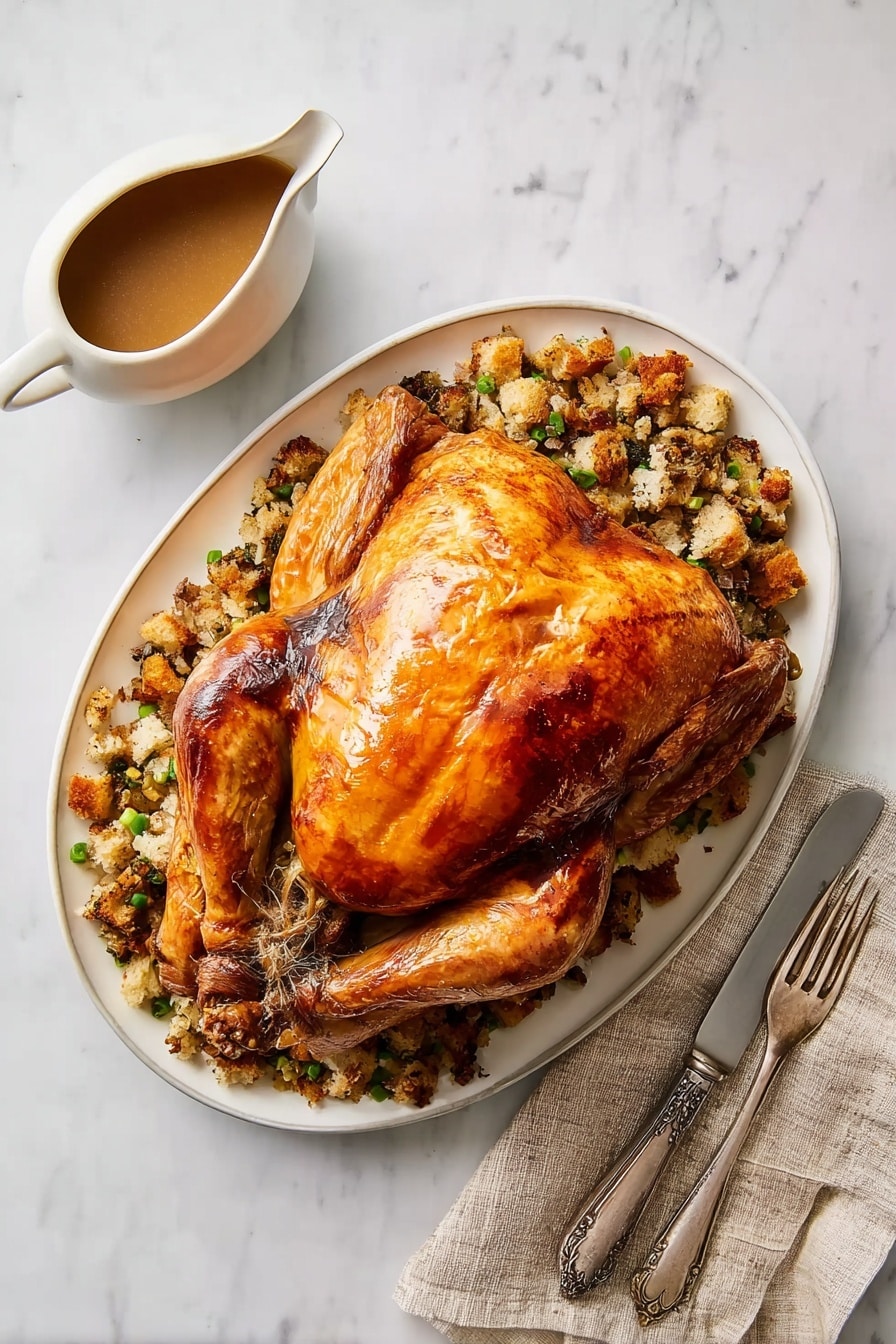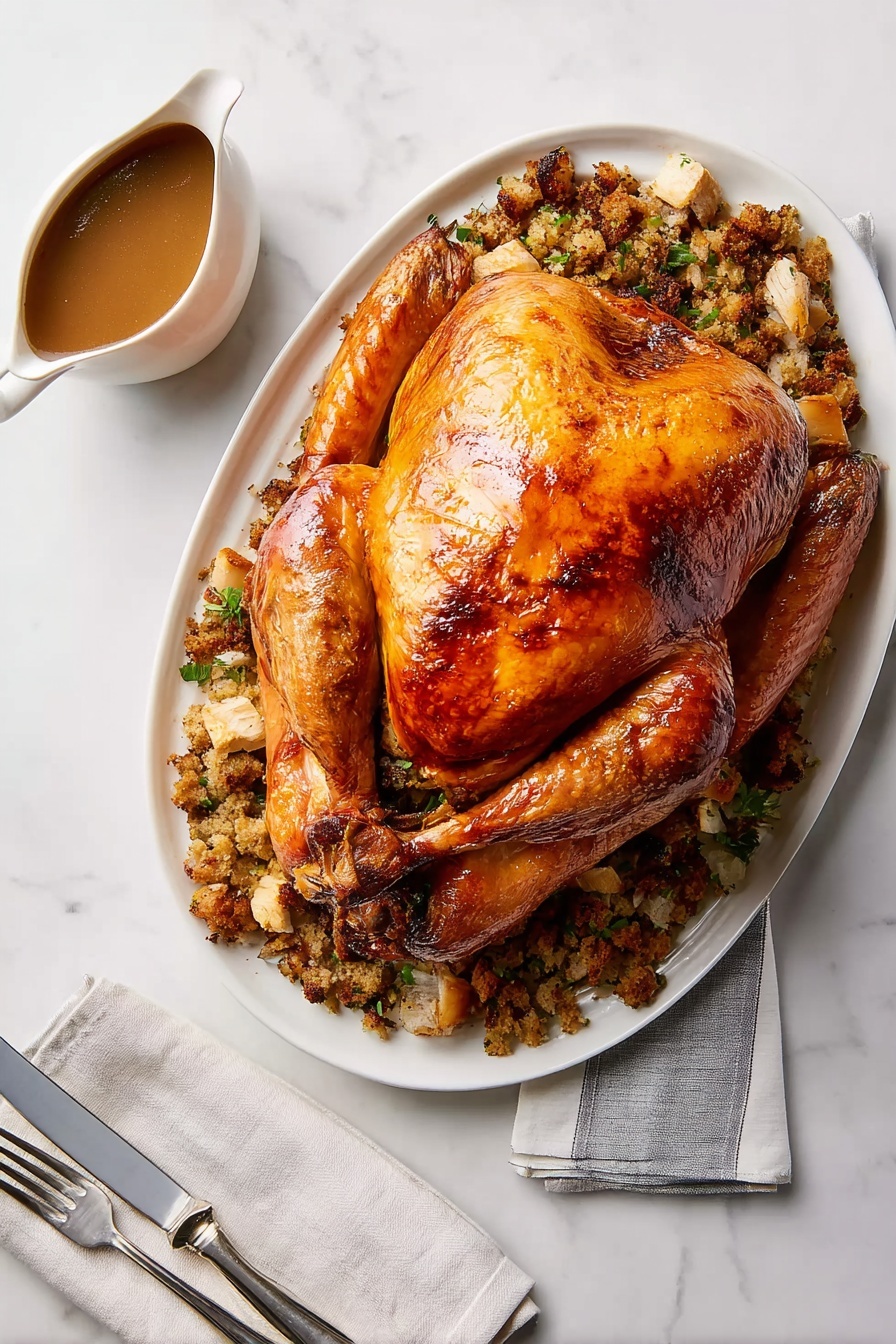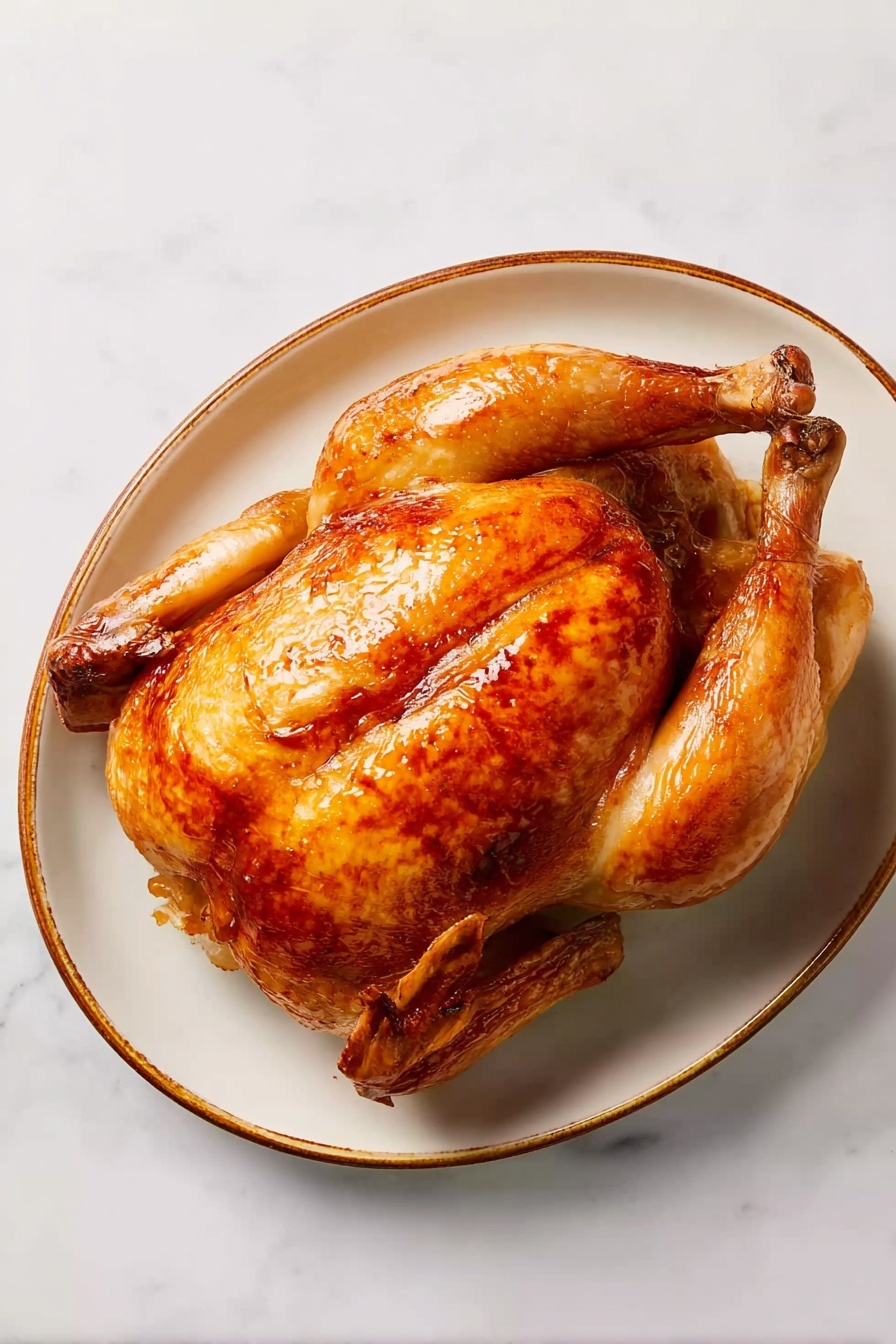If you’re on the hunt for a fail-proof method to get a perfectly juicy, golden turkey with skin that’s just the right level of crispness, you’re going to adore this Cheesecloth Roast Turkey Recipe. I absolutely love how the cheesecloth soaked in butter and wine keeps the bird moist while roasting, and your kitchen will be filled with the most inviting aroma ever. Trust me—once you try this, you’ll want to make it your go-to method for holiday feasts or any big family dinner.
Why You’ll Love This Recipe
- Consistently Moist Turkey: The cheesecloth brimming with butter and wine keeps the turkey beautifully moist from start to finish.
- Even, Golden Browning: Unlike dry roasting, this method ensures the skin browns evenly without drying out.
- Simple Yet Impressive: Even if you’re no turkey pro, this technique gives you show-stopping results without fuss.
- Perfect for Big Gatherings: Feeds a crowd, thanks to the big 20-21 lb bird, and leftovers that keep everyone happy for days.
Ingredients You’ll Need
This recipe uses simple, classic ingredients that work wonderfully together to create that rich, buttery flavor and beautiful aroma. When shopping, fresh turkey is ideal if you can get it—it really shines with this cheesecloth roasting technique.
- Fresh whole turkey: A 20- to 21-pound bird is perfect to serve a crowd and roast evenly with this method.
- Unsalted butter: Using unsalted lets you control salt levels better; melted for soaking cheesecloth, plus softened for rubbing the bird.
- Dry white wine: Adds moisture and a subtle depth of flavor; I love the way it complements the turkey’s natural juices.
- Salt and freshly ground black pepper: Basics, but absolutely essential for seasoning inside and out.
- Classic stuffing: Stuff the cavities loosely for a flavorful bonus inside the bird without overstuffing.
- Kitchen string and toothpicks: For tying legs and securing neck flap—small tools that make a big impact on roasting success.
Variations
One of my favorite things about this Cheesecloth Roast Turkey Recipe is how flexible it is—I’ve tweaked it to suit different tastes or dietary preferences, and it keeps delivering every time! Feel free to experiment a little based on what your crowd loves.
- Herb-Infused Butter: I sometimes add fresh rosemary and thyme to the melted butter for an herbal twist that makes the aroma even more magical.
- Spiced Up: For those who want a bit of a kick, sprinkling a mild chili powder or smoked paprika onto the turkey before roasting adds warmth without overpowering.
- Wine-Free Option: If you prefer to skip wine, I substitute it with chicken broth to keep that needed moisture in the cheesecloth soak.
- Smaller Birds: Using this method on smaller turkeys or even large chickens works beautifully—you just adjust cooking time accordingly.
How to Make Cheesecloth Roast Turkey Recipe
Step 1: Prep and Soak the Cheesecloth
First things first, pull your turkey out of the fridge about 2 hours before roasting to bring it to room temperature—this helps it cook evenly. Pat it dry thoroughly with paper towels; moisture on the skin can prevent proper browning. While the bird is resting, fold a large piece of cheesecloth into a four-layer, 17-inch square, then soak that cheesecloth in a mixture of melted unsalted butter and dry white wine. You want the cloth saturated but not dripping. This soaking bath is what keeps your turkey juicy and infuses each bite with subtle richness.
Step 2: Season and Stuff the Turkey
Place the turkey breast side up on a roasting rack in a heavy pan to promote airflow around the bird. Remove any pop-up timers if your bird has one — I swear by an instant-read thermometer for accuracy. Fold the wing tips under to prevent them from burning. Sprinkle salt and pepper inside both the large cavity and neck cavity, then fill these loosely with your classic stuffing—it should hold comfortably without packing tightly, which can cause uneven cooking. Tie the legs together with kitchen string for a neat, compact roast, and secure the neck flap with toothpicks. Finally, rub the turkey skin all over with softened butter, then sprinkle the rest of your salt and pepper evenly.
Step 3: Roast with the Cheesecloth
Lift your butter-and-wine-soaked cheesecloth and gently squeeze out excess liquid so it’s damp, not dripping. Lay it evenly over the turkey’s breast and halfway down the sides; some of the legs can be covered too. Pop your turkey into a 450°F oven, legs first, and roast for 30 minutes. Then, baste the cheesecloth and any exposed skin with more butter and wine using a pastry brush. Lower the heat to 350°F and continue roasting for 2½ hours, basting every 30 minutes. Keep an eye on your pan juices and spoon out any excess (keep it—this makes the best gravy later!). The cheesecloth acts like a flavorful moisture barrier, so you’re basically giving your bird a cozy bath.
Step 4: Remove Cheesecloth and Finish Roasting
After that initial 3-hour mark, carefully pull off the cheesecloth (it will be hot and tender by now). Turn your roasting pan so the breast faces the back of the oven—this helps the skin crisp up evenly. Baste gently with the pan juices or more butter and wine if the pan is dry. Since the skin is delicate now, be gentle with basting. Roast for another hour, basting halfway through. Use your instant-read thermometer to check the thigh temperature after this final roasting. You want it to reach 180°F for perfect doneness. If it’s not quite there, give it a little more time with basting, 20–30 minutes max, so it doesn’t dry out.
Step 5: Rest and Make the Gravy
Once your turkey’s golden and fully cooked, transfer it to a platter and let it rest for about 30 minutes—this step is crucial. Resting lets the juices redistribute so every slice is moist and flavorful. While that’s happening, pour the pan juices into a measuring cup and let the fat rise to the top, so you can skim it off for a leaner gravy. Use the roasting pan on the stovetop, add your favorite wine or water, and scrape up those yummy browned bits for extra flavor. Mix in giblet stock and reduce the liquid until rich and silky. Add back the defatted juices, season to your liking, strain, and serve warm alongside the turkey.
Pro Tips for Making Cheesecloth Roast Turkey Recipe
- Room Temperature Turkey: Letting the bird rest before roasting avoids cold spots and promotes even cooking, which really makes a difference.
- Don’t Overstuff the Turkey: Stuff loosely to prevent undercooked center and ensure safe internal temperatures.
- Use an Instant-Read Thermometer: This is your best friend for perfectly timed cooking — it beats relying on pop-up timers every time.
- Gentle Basting After Cheesecloth Removal: The skin can tear easily, so be gentle when brushing juices to keep it intact and gorgeous.
How to Serve Cheesecloth Roast Turkey Recipe

Garnishes
I like to dress up this turkey with fresh rosemary sprigs tucked around the platter and a handful of roasted garlic cloves—it adds beautiful aroma and looks inviting on the table. Sometimes, a few sliced oranges or cranberries scattered around add a festive pop of color and brightness that complements the richness of the turkey.
Side Dishes
My family goes crazy for classic sides like creamy mashed potatoes, green bean almondine, and tangy cranberry sauce served alongside this turkey. Roasted Brussels sprouts with bacon or a warm sweet potato casserole also pair beautifully and round out the meal perfectly.
Creative Ways to Present
For holidays or special gatherings, I’ve laid the carved turkey on a large wooden board lined with fresh herbs, pomegranate seeds, and lemon wedges. It’s such an inviting way to serve that instantly elevates the experience and always gets compliments from guests.
Make Ahead and Storage
Storing Leftovers
After the feast, I let the leftover turkey cool completely before slicing and storing it in airtight containers in the fridge. It keeps well for 3-4 days, and I always label containers with dates so nothing gets forgotten!
Freezing
If I want to save a batch for later, I freeze leftovers in freezer-safe bags, removing as much air as possible to prevent freezer burn. The turkey stays tasty for up to 3 months this way. Just thaw overnight in the fridge before reheating.
Reheating
To keep leftover turkey juicy when reheating, I gently warm it in the oven covered with foil at 325°F, adding a splash of broth or pan juices. This method prevents dryness and brings the meat back to near-fresh quality.
FAQs
-
Can I use frozen turkey for this Cheesecloth Roast Turkey Recipe?
Yes, you can, but make sure the turkey is fully thawed before starting — this can take several days in the refrigerator. The cheesecloth method works best with a fresh or completely thawed bird to ensure even cooking and proper browning.
-
What if I don’t have cheesecloth? Is there a substitute?
While cheesecloth is ideal because it’s porous and food-safe, you can try using a clean, thin cotton dish towel or muslin cloth, provided it hasn’t been treated with detergents or fabric softeners. It should be breathable and able to absorb the butter-wine mixture.
-
How do I know when the turkey is done?
The gold standard is an instant-read thermometer inserted into the thickest part of the thigh without touching bone. Look for 180°F for the turkey and 140–160°F for the stuffing. The breast temperature is less important since it cooks faster and can dry out.
-
Why is the cheesecloth soaked in butter and wine?
Soaking the cheesecloth in butter and wine creates a moist barrier on the turkey’s surface, which slowly bastes the meat as it roasts. This prevents dryness and helps the skin brown evenly with a flavorful finish.
-
Can I prepare the turkey the night before?
You can season and stuff the turkey the night before and refrigerate it uncovered or loosely covered to dry out the skin for crispier results. However, apply the butter and wine rub and cheesecloth just before roasting for best moisture retention.
Final Thoughts
When I first tried this Cheesecloth Roast Turkey Recipe, I was blown away by how moist and flavorful the bird was, with a skin that was golden without being burnt or leathery. It’s not one of those complicated, fussy recipes that intimidate you—just simple steps with a wonderful payoff. I strongly encourage you to give this method a try for your next big meal—you’ll impress your guests, love the juicy results, and find yourself coming back to this technique year after year. Consider me your turkey-roasting cheerleader, cheering you on to juicy, delicious success!
Print
Cheesecloth Roast Turkey Recipe
- Prep Time: 2 hours 15 minutes
- Cook Time: 4 hours 30 minutes
- Total Time: 6 hours 45 minutes
- Yield: 14 servings 1x
- Category: Main Course
- Method: Roasting
- Cuisine: American
Description
This classic roast turkey recipe features a unique cheesecloth method that keeps the bird moist and ensures an evenly browned, golden crust. The turkey is soaked with a mixture of butter and white wine, then slowly roasted, basted regularly for rich flavor and tenderness. Accompanied by a savory giblet gravy, this turkey is perfect for festive occasions and family gatherings.
Ingredients
Main Ingredients
- One 20– to 21-pound fresh whole turkey, giblets and neck removed from cavity and reserved
- 1.5 cups (3 sticks) unsalted butter, melted
- 4 tablespoons unsalted butter, room temperature
- One 750-ml bottle dry white wine
- 2 teaspoons salt
- 2 teaspoons freshly ground black pepper
Classic Stuffing
- Enough stuffing to loosely fill the large cavity and neck cavity of the turkey
Gravy
- 1 cup dry red or white wine (optional, for gravy)
- Giblet stock (from reserved giblets and neck)
Instructions
- Prepare Turkey: Remove the turkey from the refrigerator and packaging. Let it stand at room temperature for 2 hours to ensure even cooking. Pat the bird dry thoroughly with paper towels.
- Preheat Oven and Prepare Cheesecloth: Place a rack on the lowest level in the oven and heat the oven to 450°F. Mix the melted butter and white wine in a bowl. Fold a large piece of cheesecloth into quarters and cut a 17-inch, 4-layer square. Soak the cheesecloth in the butter and wine mixture until fully saturated.
- Position Turkey and Season: Place the turkey breast-side up on a roasting rack inside a heavy metal roasting pan. Remove any pop-up timer if present, as an instant-read thermometer is preferable. Fold the wing tips under the bird. Sprinkle 1/2 teaspoon salt and 1/2 teaspoon pepper inside both the main and neck cavities. Loosely fill these cavities with the stuffing, not packing tightly.
- Secure Turkey: Tie the legs together loosely with kitchen string for easy untying later. Fold the neck flap under the bird and secure with toothpicks. Rub the outside of the turkey with softened butter and sprinkle with the remaining 1 1/2 teaspoons salt and pepper.
- Apply Cheesecloth: Lift the soaked cheesecloth from the butter and wine, squeezing out excess but leaving it damp. Spread it evenly over the breast and about halfway down the sides of the turkey, covering some of the leg area.
- Initial Roasting: Place the turkey legs-first in the preheated oven and roast at 450°F for 30 minutes.
- Baste and Reduce Heat: Using a pastry brush, baste the cheesecloth and exposed turkey areas with the butter and wine mixture. Reduce oven temperature to 350°F and continue cooking for 2 1/2 hours. Baste every 30 minutes. Monitor pan juices; if excess accumulates, spoon some out and reserve for gravy.
- Remove Cheesecloth and Continue Roasting: After 3 hours of cooking, carefully remove and discard the cheesecloth. Turn the roasting pan so the breast faces the back of the oven. Baste the turkey with pan juices or additional butter and wine if necessary, being gentle to avoid tearing the fragile skin. Roast for 1 more hour, basting once more after 30 minutes.
- Check Doneness: After 4 hours of cooking total, insert an instant-read thermometer into the thickest part of the thigh, avoiding bone. The temperature should read 180°F, and the stuffing should be between 140°F and 160°F. If not fully cooked, baste and continue cooking for another 20 to 30 minutes.
- Rest the Turkey: When done, transfer the turkey to a serving platter and let rest for about 30 minutes to allow juices to redistribute.
- Make Gravy: Pour pan juices into a glass measuring cup and let stand for 10 minutes to allow grease to rise. Skim off the grease. Place the roasting pan over medium-high heat, add 1 cup dry red or white wine or water, and scrape up all browned bits with a wooden spoon until the liquid boils. Add giblet stock, stir, and bring back to a boil. Simmer until the liquid reduces by half, about 10 minutes.
- Finish Gravy: Add the defatted pan juices back to the pan and cook over medium-high heat for another 10 minutes until thickened to about 2 1/2 cups. Season to taste, strain into a warm gravy boat, and serve alongside the turkey.
Notes
- This method of covering the turkey with butter-soaked cheesecloth results in a moist, evenly browned bird with golden skin.
- Use an instant-read thermometer for accurate doneness rather than pop-up timers.
- Resting the turkey after roasting is crucial for juicy meat.
- Leftover stuffing can be baked separately in a buttered dish at 375°F for 45 minutes.
- Carefully baste after cheesecloth removal to avoid tearing fragile skin.
Nutrition
- Serving Size: 1 slice (approx. 6 oz cooked turkey with skin)
- Calories: 420
- Sugar: 0.5 g
- Sodium: 490 mg
- Fat: 25 g
- Saturated Fat: 12 g
- Unsaturated Fat: 11 g
- Trans Fat: 0 g
- Carbohydrates: 6 g
- Fiber: 0.8 g
- Protein: 45 g
- Cholesterol: 140 mg



